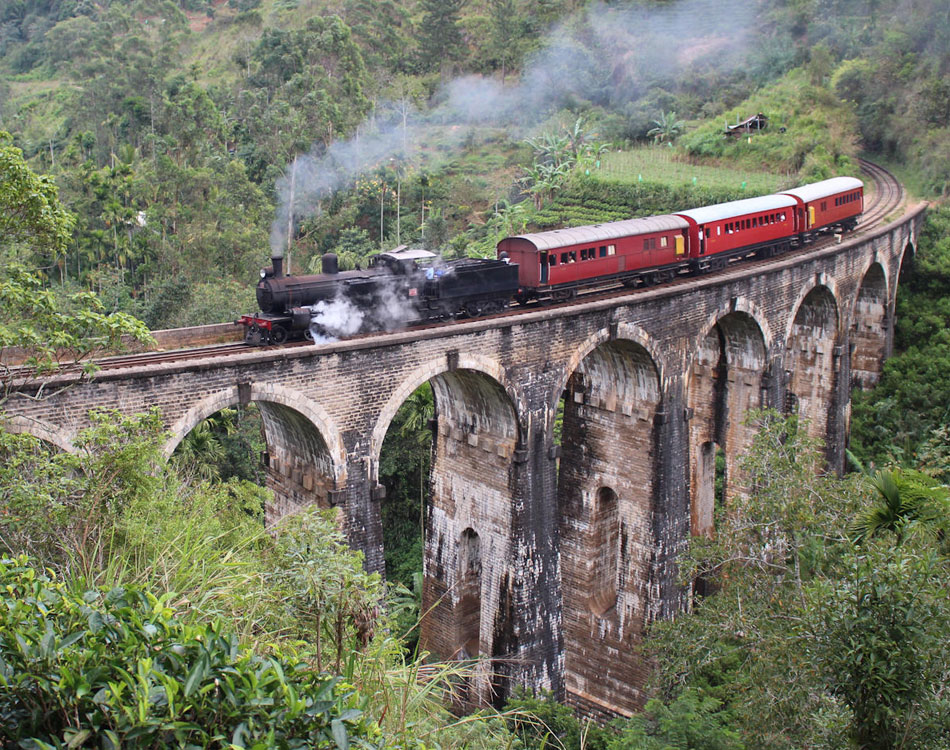NINE ARCH BRIDGE
The Nine Arch Bridge, also called as the Bridge in the Sky, is a bridge in Sri LankaLocally it is known as ‘Ahas Namaye Palama’ meaning nine skies bridge in Sinhala. The name derives from the visual experience. . It is one of the best examples of colonial-era railway construction in the country.The construction of the bridge is generally attributed to a local Ceylonese builder, P. K. Appuhami, in consultation with British engineers. The chief designer and project manager of the 'upcountry railway line of Ceylon' project was D. J. Wimalasurendra, a distinguished Ceylonese engineer and inventor. The designer of the viaduct was Harold Cuthbert Marwood of Railway Construction Department of Ceylon Government Railway. The 1923 report titled "Construction of a Concrete Railway Viaduct in Ceylon" published by the Engineering Association of Ceylon has details of all the records including the plans and drawings.
It is located in Demodara, between Ella and Demodara railway stations. Popular rumours suggest that when construction work commenced on the bridge, the Great War began between the empires of Europe and the steel assigned for this site was reallocated to Britain's War related projects at the battlefront. As a result, the work came to a standstill, leading the locals build the bridge with stone bricks and cement, but without steel.
The bridge was built at Gotuwala between the Ella and Demodara stations during the British Colonial period. And the unique part about this bridge is that it is built entirely from rocks, bricks, and cement with no use of steel or metals throughout the structure. The bridge was commissioned in 1941 and the story goes that as the bridge was being planned World War I broke out. The steel and metal materials destined to be used in the bridge were reassigned to be used for military purposes. The materials were then gathered in the form of rocks, bricks, and cement to make sure the bridge construction still went ahead.
The most famous story speaks of a man named P. K. Appuhami, who lived in the Kappatipola area in Melimada. Born in 1870, Appuhami was a famed traditional drummer and devil dancer (a ritual dance form). One day, while returning home gloomily as he lost a competition, Appuhami was seen by a British official. The man was extremely frightened by the devilish apparition (Appuhami was still in his dance costume) at the beginning; but soon became quite friendly. Learning that the strange foreigner was in his area to construct a railway, Appuhami assisted by supplying him with labour from the local villages.
But things did not go smoothly with the railway construction. They found that they were unable to bridge a large gap between two hills; as there was a quagmire in the valley in between. It was not possible to create firm anchoring, due to the marshy ground. On learning this, Appuhami requested to take over the bridge project. While he was rejected initially, they agreed later; as he had gained their trust with his assistance and friendship. As the story goes, Appuhami started working on the bridge in 1913. He solved the issue of the unstable ground by toppling giant rocks into the space; until a firm bed of rocks was formed. He then created the bridge’s brick columns over this bed and continued with the construction of the bridge.
The methods of constructions used by Appuhami proved to be so intuitive and cost effective; that he finished the entire project, which was intended to continue for many years, within a single year at a fraction of the original cost planned. The British officials were so shocked that the ‘savages’ had finished such a huge project so easily; that they refused to believe its structural integrity. At this point Appuhami is said to have sworn to the strength of the structure by saying he would prove it by lying under the bridge; when the railway line was used for the first time. Once the track was completed, he kept to his promise; awing the officials with his achievement.
Most interestingly, the story also states that Appuhami was then offered payment in the form of the balance costs that he saved with his inexpensive construction methods. The folklore speaks of the happy day when Appuhami returned to his village with four carts of silver coins. He then proceeded to spend it on meals for his village and the neighboring village for an entire two days, while also giving each villager a silver coin.
Day Tours
See more
See less
Round Tours
See more
See less
Things To Do
See more
See less

